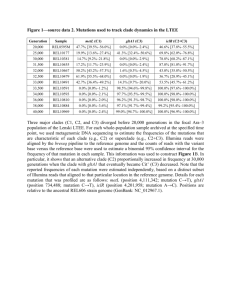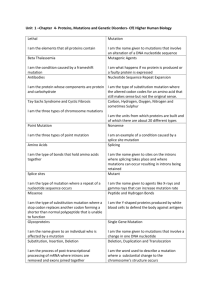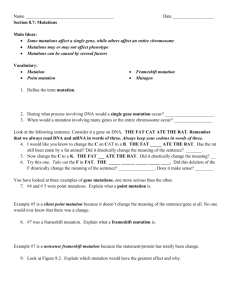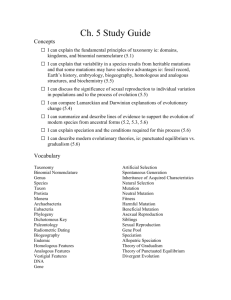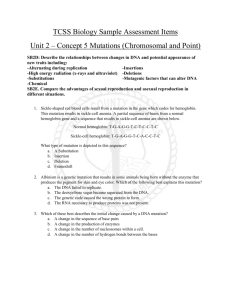Title: Probable novel PSEN2 Val214Leu mutation
advertisement
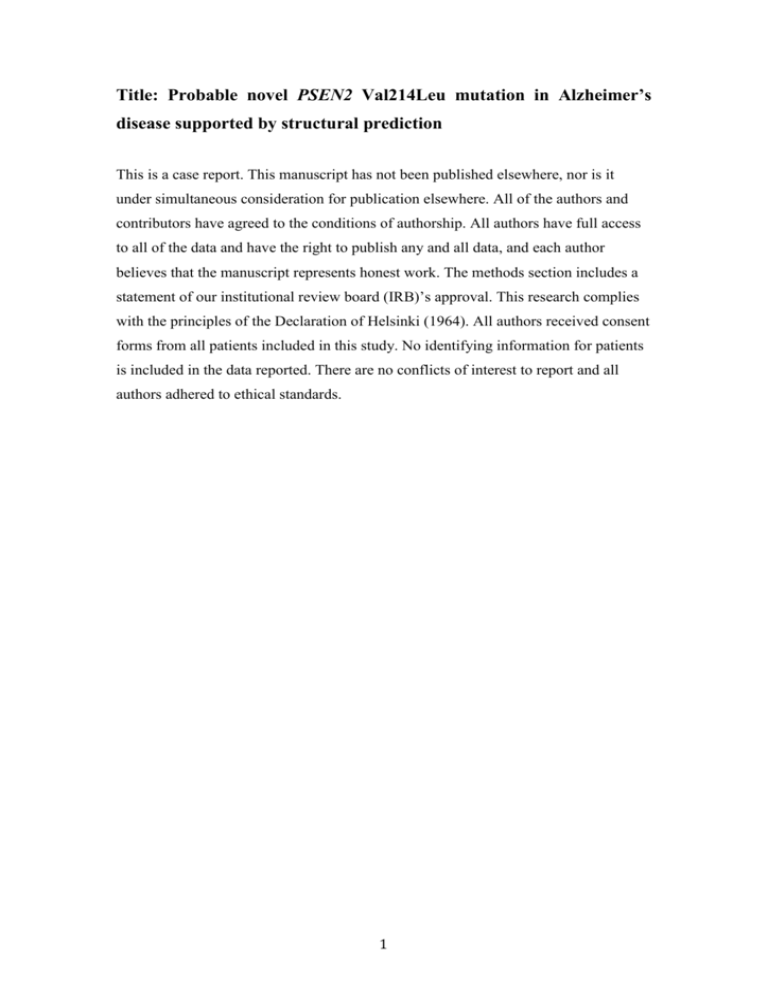
Title: Probable novel PSEN2 Val214Leu mutation in Alzheimer’s disease supported by structural prediction This is a case report. This manuscript has not been published elsewhere, nor is it under simultaneous consideration for publication elsewhere. All of the authors and contributors have agreed to the conditions of authorship. All authors have full access to all of the data and have the right to publish any and all data, and each author believes that the manuscript represents honest work. The methods section includes a statement of our institutional review board (IRB)’s approval. This research complies with the principles of the Declaration of Helsinki (1964). All authors received consent forms from all patients included in this study. No identifying information for patients is included in the data reported. There are no conflicts of interest to report and all authors adhered to ethical standards. 1 Title: Probable novel PSEN2 Val214Leu mutation in Alzheimer’s disease supported by structural prediction Young Chul Youn, MD, PhD,a Eva Bagyinszky, MS,b HyeRyoun Kim, MD, PhD,c Byung- Ok Choi, MD, PhD,d Seong Soo An, PhD,b SangYun Kim, MD, PhD.e a Department of Neurology, Chung-Ang University College of Medicine b College of Bionano Technology, Gachon Bionano Research Institute, Gachon University c Department of Laboratory Medicine, Chung-Ang University College of Medicine d Department of Neurology, Samsung Medical Centre, Sungkyunkwan University e Department of Neuology, School of Medicine, Seoul National University Bundang Hospital Young Chul Youn and Eva Bagyinszky contributed equally to this work as first authors. Running title: PSEN2 mutation supported by structural prediction Character count for the title (including spaces): 97 Number of words in the manuscript (including abstract): 1825 Address for co-correspondence: SangYun Kim, MD, PhD and Seong Soo An, PhD SangYun Kim, MD, PhD Department of Neurology, Seoul National University Bundang Hospital, Seoul National University College of Medicine, 300 Gumidong, Bundang-gu, Seongnam-si, Gyeonggi-do, 463-707, South Korea Tel:+82-31-787-7462 Fax: +82-31-719-6815 E-mail: neuroksy@snu.ac.kr Seong Soo A. An, PhD Department of Bionano Technology, Gachon Bionano Research Insitute, Gachon University, 1342Sungnam-daero, Sujung-gu, Seongnam-si, Gyeonggi-do, 461-701, South Korea Tel:+82-31-750-8755 2 Fax: +82-31-750-8755 E-mail: seong.an@gmail.com Financial Disclosure: This research was supported by a grant of the Korea Healthcare technology R&D Project, Ministry of Health and Welfare, Republic of Korea (HI10C2020) and by the National Research Foundation of Korea (NRF) grant funded by the Korea government (MEST, No. 2010-0024004). Dr. Youn YC receives a grant of the Korea Healthcare technology R&D Project, Ministry of Health and Welfare, Republic of Korea (HI10C2020). Dr. An SS receives the National Research Foundation of Korea (NRF) grant funded by the Korea government (MEST, No. 2010-0024004). M.Sc. Eva Bagyinszky reports no disclosure. Dr. Kim HR reports no disclosure. Dr. Choi B reports no disclosure. Dr. Kim S reports no disclosure. 3 Title: Probable novel PSEN2 Val214Leu mutation in Alzheimer’s disease supported by structural prediction Abstract Background: PSEN2 mutations are rare variants, and fewer than 30 different PSEN2 mutations have been found. So far, it has not been reported in Asia. Case presentation: PSEN2 mutation at codon 214 for predicting a valine to leucine substitution was found in two patients with memory impairment from unrelated Korean families. One patient was a 70-year-old woman, who showed a dementia of the Alzheimer type. A second patient was a 55-year-old woman with amnestic mild cognitive impairment, whose only daughter was diagnosed with the osteogenesis imperfecta. We did not find the mutation in 614 control chromosomes. We also predicted the structures of presenilin 2 protein with native Val 214 residue and Leu 214 mutation, which revealed significant structural changes in the region. Conclusion: It could be a novel mutation verified with structural prediction in two patients with memory impairment from different families. Key words: Alzheimer's disease; Presenilin 2 mutation; Presenilin 2 protein structure; Novel mutation; Structural prediction; Osteogenesis imperfecta. 4 1. Introduction Well-known mutations associated with autosomal dominant Alzheimer’s disease (AD) inheritance are amyloid precursor protein (APP) and presenilin 1 (PSEN1) and presenilin 2 (PSEN2).1, 2 Previous studies have shown several APP and PSEN1 mutations in Asian populations, but pathogenic PSEN2 mutation has not yet been described.3, 4 We had screened PSEN2 mutation in 90 AD patients of two memory clinics from May to December 2012. Here, unrelated two patients of East Asian descent with memory complaint are found with a probable novel Val214Leu mutation at PSEN2 exon 7. 2. Case Report Two female patients, who developed insidious memory loss, were examined in two different memory clinics. The first case was a 70-year-old right-handed female, who complained progressive memory problems, which started 1 year prior to the initial visit. She reported her frequent forgetfulness of going to important meetings and had difficulties in grocery shopping. She also reported in having a tremor in her right hand for the past 20 years, persistent during resting and forearm stretching stances, which did not progress further. She presented with slightly decreased facial expressions, but did not show rigidity, ataxia, myoclonus, or seizure. Since she was separated from her other family members during the Korean War, we could not obtain her family history. Her Korean version of Mini-Mental Status Examination (KMMSE) was 18 and CDR-sum of boxes was 4.5. She also underwent neuropsychological tests using a standardized neuropsychological battery called the Seoul Neuropsychological Screening Battery (SNSB).5 She had normal spontaneous speech and comprehension. Her SNSB showed digit span forward was 16.86%ile; 5 Korean-Boston naming test, 12.09%ile; Rey–Osterrieth Complex Figure Test copy, 0.01%ile; calculation, < 5%ile; Seoul Verbal Learning Test-delayed recall, 1.05%ile; Rey–Osterrieth Complex Figure-delayed recall test, 2.09%ile; Digit Symbol Coding, 1.15%ile; Korean Stroop test-color reading, 11.46%ile; Controlled Oral Word Association Test, 0.01%ile. She also revealed the BPO (body part as object) error when doing praxis test. Fist-edge-palm and alternating hand movement, motor impersistence test were normal, but Luria loop and alternating square and triangle were deformed and perseverative. Neuropsychological tests revealed severe verbal memory impairment, which was not improved by cues. In addition, she showed visuospatial dysfunction and difficulty in calculation and frontal executive function. Her brain MRI (Figure 1 a) showed diffuse cortical atrophy with mild white matter hyperintensities in FLAIR images, and FDG-PET (Figure 1 b) revealed bilateral temporoparietal and precuneus hypometabolism. A diagnosis of probable AD was made. She had an APOE ε3/4 polymorphism, but other laboratory tests were normal. The second case was a 55-year-old left-handed female patient, who was a Korean-American living in North America and had complained of difficulties in finding important things and behavioral disturbances, such as irritability and anxiety. Our clinical impression of her was amnestic mild cognitive impairment (MCI). Her family history was negative for any neurodegenerative or psychiatric disease, but her only daughter was diagnosed with the osteogenesis imperfecta. At presentation, the neurological examination was normal. Her APOE genotype was ε3/3, and other laboratory abnormality was not found. 3. Genetic analysis of PSEN2 and structural prediction of mutant PSEN 2 protein 6 DNA was extracted from the buffy coat of the venous blood samples using a blood DNA isolation kit (GeneAll Inc., Seoul, South Korea). APP exon 16 and 17, PSEN 1 exon 4, 5, 6, 7, 8, and 11, PSEN 2 exon 4, 5, 6, 7, and 12, the coding region of the PRNP gene, mutations in the microtubule-associated protein tau (MAPT) and progranulin (GRN) were amplified by PCR for genetic analysis. A sizing-genotyping and repeat-primed PCR were performed to monitor the presence of the abnormal repeat expansions of C9orf72. Single-strand conformation polymorphism (SSCP)6 and Surveyor nuclease assay kit7 revealed alternative migration and cleavage patterns in comparison to normal (Figure 2 a, b), strongly suggesting the presence of mutation in the PCR product of PSEN 2 exon 7. All PCR products were sequenced for the confirmation. We found a valine to leucine substitution (Val214Leu) at exon 7 of PSEN2 in both patients (Figure 2 c). This PSEN2 mutation could be considered as a novel mutation, since 614 control chromosomes (307 subjects: 140 healthy control, 90 AD, 15 mild cognitive impairment, 12 subjective memory impairment, 10 frontotemporal dementia, 5 vascular cognitive impairment, 35 unclassified patients) were also screened for Val214Leu mutation without any evidence, in support of the present finding. The structures of presenilin 2 with native Val 214 residue and Leu 214 mutation were generated by RaptorX 3D prediction program. Overall structural features were identical between the native presenilin 2 with Val 214 residue and Leu mutation. However, the side-chains of Val and Leu 214 residues reveal noticeable changes of extending towards opposite direction. In addition, other proceeding residues, Ile 219 and His220, revealed significant changes in their side-chains (Figure 3). 7 Polymorphism Phenotyping v2 (PolyPhen 2, http://genetics.bwh.harvard.edu/pph2/) online program for predicting the putative pathogenic phenotype was also used to evaluate PSEN2 Val214Leu mutation by analyzing the non-synonymous mutations in the coding region.8 PolyPhen2 compared the wild-type sequences and the mutant sequences by using sequence-and structurebased predictive features, based on maping the missense mutations to the transcriptomes, performes protein sequence annotations and structural comparisons. Next, PolyPhen 2 performed a multiple alignment of sequences from different organisms. In addition, it could provide 3D structure of the protein by searching protein data bank database. Two types of datasets, HumDiv and HumVar, were available from PolyPhen 2, which were calculated from position-specific independent counts (PSIC) scores of normal and mutant allele. For PSEN2 Val214Leu, the HumDiv score was 0.972 (sensitiviy: 0.77; specificity: 0.96), which indicated as probably damaging mutation with the HumVar score of 0.836 (sensitiviy: 0.73; specificity: 0.88), as possibly damaging mutation. 4. Discussion We detected a single nucleotide polymorphism on exon 7 of PSEN2 in 2 cases of unrelated families. So far, a pathological PSEN2 mutation has not been reported in Asia. Particularly, Val214Leu at PSEN2 was not reported previously and also was not found in general Korean population. This is suggesting as a probable novel PSEN2 mutation in association with these AD and MCI patients. Upon structural prediction of native and mutant presenilin 2 by using RaptorX program, the results revealed significant structural changes in the region (Figure 3). When two structures of Val 214 and Leu mutant were superimposed, the where side-chains of Val 214 and Leu 8 214 were pointing to opposite direction, suggesting drastic alterations in the region. Additional residues, Ile219 and His220, also revealed dramatic changes, supporting that Val replacement to Leu could cause overall structures and function of presenilin 2 (unpublished result, An’s personal communication). On the other hand, many other pathogenic mutations of Val replacement to Leu were reported.9, 10 PolyPhen2 and other bioinformatic algorithms could be used for predicting the pathogenic nature of novel mutations or known mutations.11, 12 Since cell models and in vitro/in vivo experiments would be costy, in silico estimations and simulations could aid in understanding the pathogenic or non-pathogenic nature of mutations. The prediction for PSEN2 Val214Leu by Polyphen2 provided HumDiv and HumVars scores of 0.972 and 0.836. Hence, These analyses suggested the PSEN2 Val214Leu mutation could be a possibly strong damaging variant. Multiple sequence alignment for PSEN2 was performed in comparison with different organisms. Analysis predicted that the vertebrates, such as rhesus macaque, african elephants pigs, dog, duck, revealed the normally codon Val at 214. However, few organisms (invertebrates, mostly unicellular organisms) revealed the alterations, Leu, Gly, Ile or Met, at the same Val214 position. For example, Methionine, isoleucene, or leucine were found in the Tribolium castaneum, Trichoplax adhaerens, and Entamoeba histolytica, respectively. PSEN2 V214 seemed to be strongly conserved in 115 species and mutations of Leu, Gly, Ile or Met were found in 8 species. AD patients who have exon-7 PSEN2 have reported wide spectrum of cognitive and non-cognitive symptoms. They could initially show anxiety and irritability along with mild deficits in memory, attention, and language. Then they could also show seizure and myoclonus. Some patients present global cognitive impairment at first. Exon-7 9 PSEN2 mutation revealed an age range of onset between 45 and 85 years overlapping early and late onset AD.13-15 This could be explained by the demonstrated tendencies of PSEN2 mutations in presenting lower penetrance and appearing a later and more variable age of onset than the other early-onset AD gene mutations.16 Although the first subject showed a multi-domain cognitive impairment with decreased facial expression and non-progressing right hand tremor, her significant memory impairment was the initial main complaint at age 69 and prominent temporoparietal lobe dysfunction supported by FDG-PET, no abnormal repeat expansion of C9orf72 and no other mutation in MAPT and GRN, which could be clinically classified as late-onset AD. Because her family was separated during Korean War, family history was limited. We could not find any other affected family member. The second patient showed irritability and anxiety with forgetfulness. The tests for GRN, MAPT and C9orf72 were negative also. Her only daughter was diagnosed with osteogenesis imperfecta. Presenilin 2 seemed to be working in concert with other enzymes, as a γ-secretase in cleaving amyloid precursor protein (APP) to generate amyloid-β peptides, which could be deposited as aggregates in the brain in AD patients. In addition, γ-secretase also cleaves molecules that regulate osteoblast activity, such as Notch and ephrinB2, where APP may function as a regulator of osteoblast activity.17 Therefore, the possible mechanisms underlying the pathogenesis of her AD may influence on her daughter’s bone pathology. The patient refused any genetic testing for her daughter. When considering diagnoses atypical AD patients, we can do CSF Aβ 1-42 analysis or Pib-PET supporting an AD diagnosis. Even though she did not perform CSF and Pib-PET study, we considered the first patient as probable AD because she initially complained memory problem confirmed with a neuropsychological test and 10 showed bilateral hippocampal atrophies in structural MRI and hypometabolism of bilateral temporoparietal area and precuneus in FDG-PET. Even though, this report is providing limited evidence of pathogenicity, to our knowledge, this is the first case report of AD with this probable novel PSEN2 Val214Leu mutation verified with structure prediction. Consent Written informed consent was obtained from the patient for publication of this Case report and any accompanying images. A copy of the written consent is available for review by the Editor of this journal. Competing interests The authors declare that they have no competing of interests. Authors’ contributions Young Chul Youn and Eva Bagyinszky contributed equally to this work as first authors. Young Chul Youn: drafting/revising the manuscript for content, analysis and interpretation of data. Eva Bagyinszky and Seong Soo An: performing the genetic analyses, predicting presenilin 2 protein structure and interpretation of the data. HyeRyoun Kim: preparing the samples and drafting/revising the manuscript for content. Byung-Ok Choi: verifying the mutations in the general population, and interpretation of data. SangYun Kim: analysis or interpretation of data, study supervision, obtaining funding. 11 Acknowledgements This research was supported by a grant of the Korea Healthcare technology R&D Project, Ministry of Health and Welfare, Republic of Korea (HI10C2020) and by the National Research Foundation of Korea (NRF) grant funded by the Korea government (MEST, No. 2010-0024004). 12 REFERENCES 1. Bertram L, Lill CM, Tanzi RE. The genetics of Alzheimer disease: back to the future. Neuron 2010;68:270-281. 2. Cruts M, van Duijn CM, Backhovens H, et al. Estimation of the genetic contribution of presenilin-1 and -2 mutations in a population-based study of presenile Alzheimer disease. Human molecular genetics 1998;7:43-51. 3. Park HK, Na DL, Lee JH, Kim JW, Ki CS. Identification of PSEN1 and APP gene mutations in Korean patients with early-onset Alzheimer's disease. Journal of Korean medical science 2008;23:213-217. 4. Thajeb P, Wang P, Chien CL, Harrigan R. Novel polymorphisms of the amyloid precursor protein (APP) gene in Chinese/Taiwanese patients with Alzheimer's disease. Journal of clinical neuroscience : official journal of the Neurosurgical Society of Australasia 2009;16:259-263. 5. Ahn HJ, Chin J, Park A, et al. Seoul Neuropsychological Screening Batterydementia version (SNSB-D): a useful tool for assessing and monitoring cognitive impairments in dementia patients. Journal of Korean medical science 2010;25:10711076. 6. Hayashi K. PCR-SSCP: a simple and sensitive method for detection of mutations in the genomic DNA. PCR Methods Appl 1991;1:34-38. 7. Kim J, Bagyinszky E, Chang YH, et al. A novel PSEN1 H163P mutation in a patient with early-onset Alzheimer's disease: clinical, neuroimaging, and neuropathological findings. Neurosci Lett 2012;530:109-114. 8. Adzhubei IA, Schmidt S, Peshkin L, et al. A method and server for predicting damaging missense mutations. Nature methods 2010;7:248-249. 9. Queralt R, Ezquerra M, Lleo A, et al. A novel mutation (V89L) in the presenilin 1 gene in a family with early onset Alzheimer's disease and marked behavioural disturbances. Journal of neurology, neurosurgery, and psychiatry 2002;72:266-269. 10. Jia J, Xu E, Shao Y, Sun Y, Li D. One novel presenilin-1 gene mutation in a Chinese pedigree of familial Alzheimer's disease. J Alzheimers Dis 2005;7:119-124; discussion 173-180. 11. Cherbal F, Salhi N, Bakour R, Adane S, Boualga K, Maillet P. BRCA1 and BRCA2 unclassified variants and missense polymorphisms in Algerian breast/ovarian cancer families. Disease markers 2012;32:343-353. 12. Catucci I, Milgrom R, Kushnir A, et al. Germline mutations in BRIP1 and PALB2 in Jewish high cancer risk families. Familial cancer 2012;11:483-491. 13. Finckh U, Alberici A, Antoniazzi M, et al. Variable expression of familial Alzheimer disease associated with presenilin 2 mutation M239I. Neurology 2000;54:2006-2008. 14. Jayadev S, Leverenz JB, Steinbart E, et al. Alzheimer's disease phenotypes and genotypes associated with mutations in presenilin 2. Brain : a journal of neurology 2010;133:1143-1154. 15. Marcon G, Di Fede G, Giaccone G, et al. A novel Italian presenilin 2 gene mutation with prevalent behavioral phenotype. Journal of Alzheimer's disease : JAD 2009;16:509-511. 16. Tandon A, Fraser P. The presenilins. Genome biology 2002;3:reviews3014. 17. McLeod J, Curtis N, Lewis HD, Good MA, Fagan MJ, Genever PG. Gammasecretase-dependent cleavage of amyloid precursor protein regulates osteoblast 13 behavior. FASEB journal : official publication of the Federation of American Societies for Experimental Biology 2009;23:2942-2955. Figure Legends Figure 1. Axial FLAIR, coronal and sagittal T1 images of brain MRI (a) and statistical parametric maps (21 age matched control subjects (70.3±1.4 yr); p < 0.001, uncorrected; extent threshold = 10 voxels) of FDG-PET (b) of the first subject. The color scale of statistical parametric maps indicates the Z value magnitude, with the lowest value appearing in dark red and the highest value in bright yellow/white. Figure 2. Genetic analysis in finding novel Val214Leu mutation at PSEN2 exon 7. After PCR amplification of APP exon 16 and 17, PSEN 1 exon 4, 5, 6, 7, 8, and 11, PSEN 2 exon 4, 5, 6, 7, and 12, and the coding region of the PRNP gene, PCR amplicons were analysis by singlestrand conformation polymorphism (SSCP, a) and Surveyor nuclease assay (b). PCR amplicon from AD patient showed different cleavage pattern than the normal control by nuclease, as indicated with red arrows (c). All PCR amplicons were sequenced with primers, used in PCR amplification. Novel mutation of Val214Leu at PSEN 2at exon 7 of the patient was obtained, where GTG of Val was converted into TTG of Leu at 5’ direction (red arrow) and CAC to CAA at 3’ direction (green arrow). 14 Figure 3. Superimposed structures of presenilin 2 with native Val 214 residue and Leu mutation. The structures of presenilin 2 with native Val 214 residue and Leu mutation were generated by RaptorX 3D prediction program. The side-chains of Val and Leu 214 residues reveal noticeable changes of extending towards opposite direction (a). Green color CPK (Corey, Pauling, Koltun) indicates the side-chain of native Val residue and the red color indicated the Leu mutation. Other proceeding residues, Ile 219 and His220, revealed significant changes in their side-chains (b). Green colored side-chains indicated the Ile and His residues from the native form and red colored side-chains indicated the mutant presenilin 2. 15


